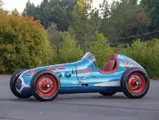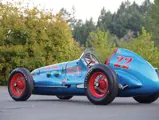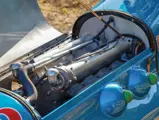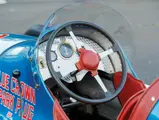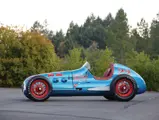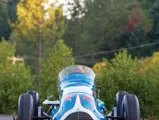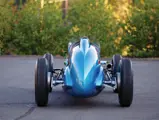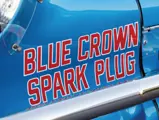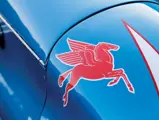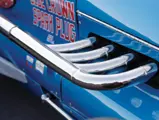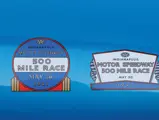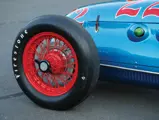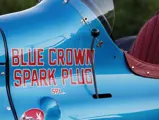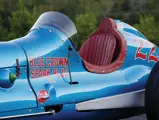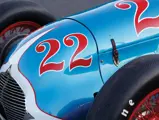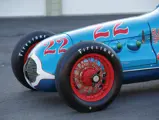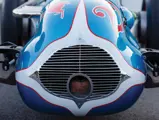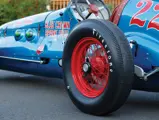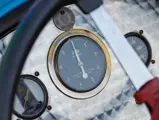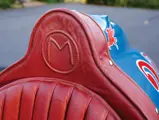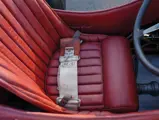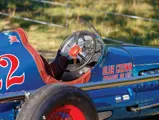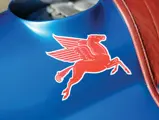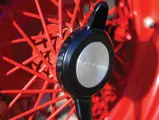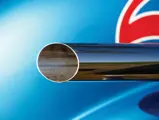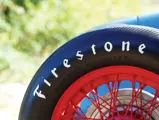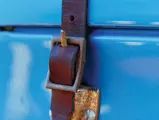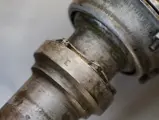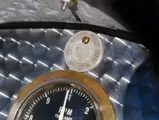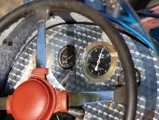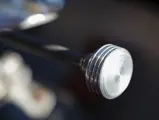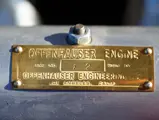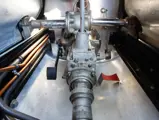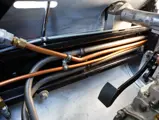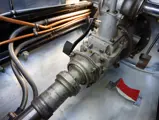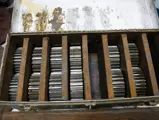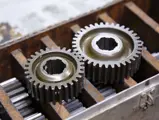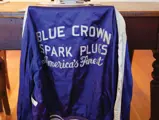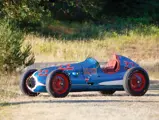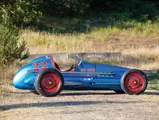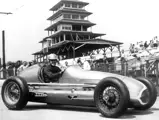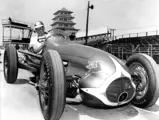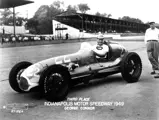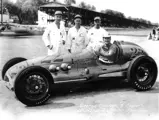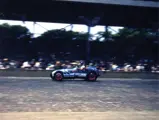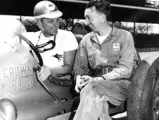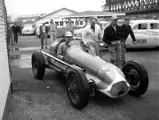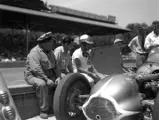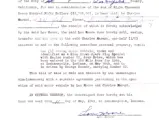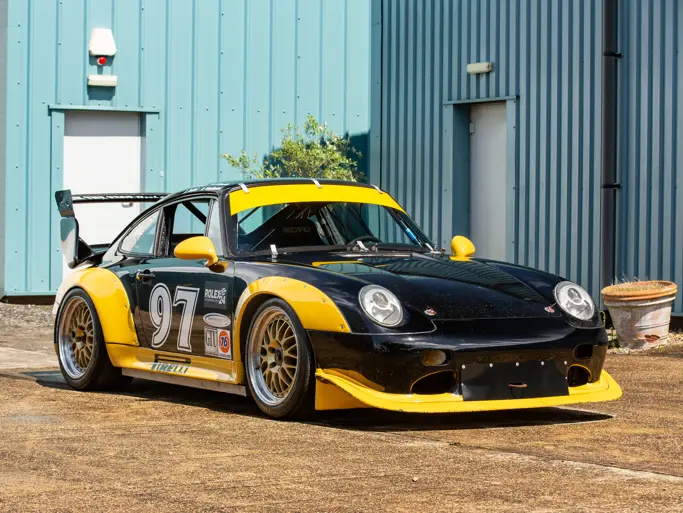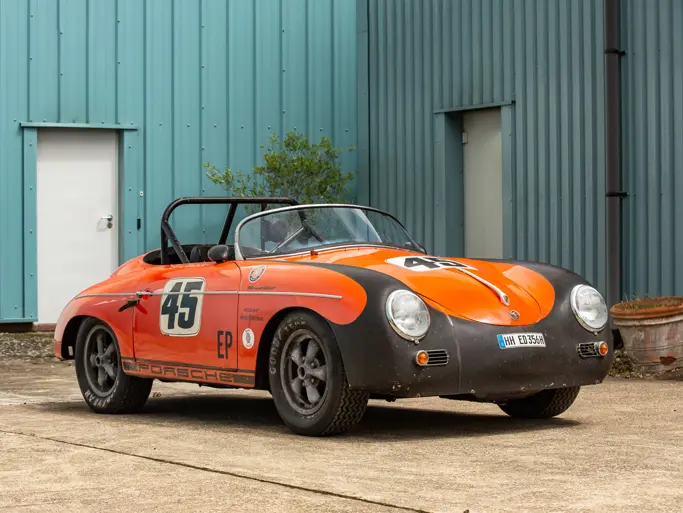Monterey 2015
1949 Lesovsky-Offenhauser Indianapolis "Blue Crown Special"
{{lr.item.text}}
$302,500 USD | Sold
 | Monterey, California
| Monterey, California
{{internetCurrentBid}}
{{internetTimeLeft}}

- The famous Baby Blue Crown; built for Lou Moore’s Blue Crown Spark Plug team
- Driven by George Connor to 3rd overall at the 1949 Indianapolis 500
- Restored by vintage Indy car expert Jim Mann
- Accompanied by a wonderful collection of archival materials
Est. 300 bhp, 270 cu. in. DOHC Offenhauser inline four-cylinder engine with two Flynn side-draft carburetors, three-speed Meyer-Drake transmission with reverse, independent torsion bar front suspension, cross-spring rear suspension, a Pat Warren quick-change center section, duplex-type dual drag-link steering, and four-wheel drum brakes. Wheelbase: 97.5 in.
Lou Moore could be called the Roger Penske of his era. First appearing at Indianapolis in 1926 driving a Miller 91, he ran a Southern California-based operation sponsored by Blue Crown Spark Plugs, known for its first-class equipment, professionalism, and preparation. They won the Indianapolis 500 no fewer than five times.
The car offered here, known in period as the Baby Blue Crown, was built for the Blue Crown Spark Plug team in 1948 by Luigi Lesovsky. While many race car chassis of the time began with chalk lines on a shop floor, Lesovsky’s were created on the drafting board; he was uncompromising in his quest for precise work and innovation. The design of this car, for instance, was configured with rear-wheel drive on a shorter wheelbase than the Blue Crown team’s two front-drive cars, and it expanded the team’s reach to AAA events on shorter tracks, where the front-drive’s bulk made it noncompetitive.
While Lesovsky handled the fabrication of the chassis, tanks, and body, Pat Warren, of Downey Machine, provided the running gear, including a rear axle assembly with a deeply finned quick-change center section and unique independent front suspension. Gordon Schroeder is believed to have built the dual drag-link steering, while the Offenhauser engine and transmission came from Meyer and Drake Engineering.
The car made its Indianapolis debut in 1948, but neither driver Mack Hellings or Mike Salay were able to qualify it for the race. On May 11, 1949, Lou Moore sold one-half interest in the car for $8,750 to his crew chief, Charlie Marant. (The original Bill of Sale from Moore to Marant, including the Affidavit of Ownership, is included with the car’s file.) George Connor proceeded to qualify the car in 6th position for the 500 that year and pushed heroically all the way to the podium, with an impressive 3rd overall. Bill Holland drove it at two subsequent AAA races that year at Milwaukee and Trenton. Then, Connor piloted the car in two more Indy 500s for Moore, finishing 8th in 1950 and 30th in 1951. Unwilling to retire the increasingly obsolete warhorse, Charlie Marant independently entered the car at Indianapolis in 1952 and 1953, but driver Bill Taylor was unable to qualify either year.
However, the Special wasn’t quite done with the Brickyard. In 1954, second owner Bob Christie attempted to qualify the car. A hot shoe, Christie was running plenty fast enough to make the cut, until a failed magneto put an end to the Indianapolis aspirations of the race car that made its debut there in 1949. It was later sold to Malcolm Miller, of Vancouver, Washington, who campaigned it at Pacific Northwestern tracks with driver Bob Gregg, who won several races. The racer was finally sidelined by an accident at Sacramento in 1955, with Len Sutton at the wheel, and was traded by Miller to Donald “Duck” Collins, of Portland, Oregon, who preserved the numerous unique and irreplaceable surviving components, many of which were stamped with its chassis number, 3. The extensive remains of Baby Blue Crown were passed to Del McClure after Collins’s death and then on to the consignor. These included all suspension, transmission, rear end, and other constituent driveline parts.
Jim Mann’s renowned shop in Elkhart, Indiana, restored the car, with 270 Offenhauser engine parts sourced and assembled by Steve Truschan, using as many of the original components as possible; what was missing or damaged was reproduced by Mr. Mann’s skilled hands. Correct 18-inch Rudge wire wheels were sourced and mounted with rare period Firestone Indianapolis racing tires. While the restoration was underway, the consignor proved himself a voracious digger for historical information and was a frequent correspondent with the Indianapolis Motor Speedway Hall of Fame Museum. He was successful in collecting numerous objects pertaining to Baby Blue Crown and built a collection of documents, dozens of period photographs, and related materials that are provided with the car. Former owner Bob Christie and his crew chief inspected, recognized, and verified the original components. An original, full set of quick change gears uniquely produced for this rare rear axle is also included with the Special. For display, George Connor’s original racing jacket is included. Additionally, the actual “lucky coin” struck for George in 1938 when he was racing the Marks Special is attached to the dashboard!
Despite the thoroughness and quality of the restoration, the restored Lesovsky-Offenhauser has not been in operation since its completion, and therefore, the consignor recommends a careful commissioning before any further track-day activities.
With its classic Indy car look, Blue Crown Special is one of the most interesting and attractive Indianapolis racers available today from the Roadster Era. This beautifully restored and historically significant machine is an exciting addition to any collection of racing cars.
Gentlemen, start your engines!

